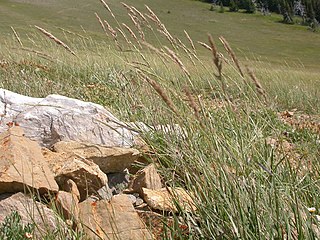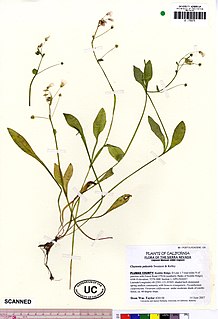
Dryas is a genus of perennial cushion-forming evergreen dwarf shrubs in the family Rosaceae, native to the arctic and alpine regions of Europe, Asia and North America. The genus is named after the dryads, the tree nymphs of ancient Greek mythology. The classification of Dryas within the Rosaceae has been unclear. The genus was formerly placed in the subfamily Rosoideae, but is now placed in subfamily Dryadoideae.

Claytonia perfoliata, also known as miner's lettuce, Indian lettuce, winter purslane, or palsingat (Cahuilla), is a flowering plant in the family Montiaceae. It is an edible, fleshy, herbaceous, annual plant native to the western mountain and coastal regions of North America.

Claytonia virginica, the Virginia springbeauty, eastern spring beauty, grass-flower or fairy spud, is an herbaceous perennial plant in the family Montiaceae. Its native range is eastern North America. Its scientific name honors Colonial Virginian botanist John Clayton (1694–1773).

Calamagrostis purpurascens, is a perennial grass commonly known as purple reedgrass, purple pinegrass, or alpine reedgrass. It grows 30 to 80 centimetres (31 in) tall.

Claytonia is a genus of flowering plants native to Asia, North America, and Central America. The vitamin-rich leaves can be eaten raw or cooked, and the tubers can be prepared like potatoes.

Claytonia sibirica, the pink purslane, candy flower, Siberian spring beauty or Siberian miner's lettuce, is a flowering plant in the family Montiaceae, native to the Commander Islands of Siberia, and western North America from the Aleutian Islands and coastal Alaska south through the Queen Charlotte Islands, Vancouver Island, Cascade and Coast Ranges, to a southern limit in the Santa Cruz Mountains. Populations are also known from the Wallowa Mountains, Klamath Mountains, northern Idaho, and The Kootenai. A synonym is Montia sibirica. The plant was introduced into the United Kingdom by the 18th century, where it has become very widespread.

Claytonia exigua is a species of wildflower known by the common names serpentine springbeauty and pale claytonia, in the family Montiaceae.

Claytonia megarhiza is a species of wildflower in the family Montiaceae known by the common names fell-fields claytonia and alpine springbeauty. The specific epithet megarhiza is Greek for "large roots".

Claytonia palustris is a species of wildflower in the family Montiaceae known by the common names Jonesville springbeauty and marsh claytonia.

Claytonia rubra is a species of wildflower in the family Montiaceae known by the common names redstem springbeauty and erubescent miner's lettuce. It is native to western North America from southwestern Canada to the Transverse Range of California, U. S. A. (and east to the Black Hills of South Dakota, U. S. A., where it is found in coniferous forests and shrublands. This is an annual herb with stems up to about 15 centimeters long. Some individuals may overwinter as biennials. The basal leaves have small rounded to diamond-shaped blades on long, tapering petioles. There are also leaves on the stem which may be rounded or squared and sometimes fuse together to create a bowl around the stem. All the leaves possess blunt tips according to published descriptions and taxonomic treatments. The herbage is red or pink in color at all stages of development. The inflorescence is a dense cluster of up to 30 tiny flowers, each with petals less than 4 millimeters long and white to pink-tinted in color. Together with Claytonia perfoliata and Claytonia parviflora, Claytonia rubra comprises what is almost certainly a polyploid pillar complex based on three diploid species, each occupying a definitive ecological niche

Salix brachycarpa is a species of flowering plant in the willow family known by the common names barren-ground willow, small-fruit willow and shortfruit willow.
Luzula nivalis, commonly known as arctic wood-rush or less commonly as snowy wood-rush, is a species of perennial rush native to the North American Arctic and Northern Europe. It was described by Polunin (1940) as one of the most abundant, ubiquitous, and ecologically important of all arctic plants.

Claytonia caroliniana, the Carolina springbeauty, is an herbaceous perennial in the family Montiaceae. It was formerly placed in the Portulacaceae. Its native range is eastern and central North America. It is most commonly found in the New England area of the United States but its habitat extends from Ontario and a northern limit in the Cape Anguille Mountains of Newfoundland and south to Alabama. It grows approximately 6 inches tall in forests of the Appalachian Mountains and piedmont
Claytonia tuberosa, commonly known as Beringian springbeauty or tuberous springbeauty, is a species of flowering plant in the family Montiaceae. It is a perennial herb indigenous to Alaska, British Columbia, Northwest Territories, and the Yukon of North America, westward to East Asia–Siberia. The perennial grows from a globose tuberous root to a height of 15 centimetres (6 in) and bears several hermaphrodite white flowers on stems bearing a single pair of petiolate cauline leaves. Its closest relative is probably Claytonia virginica.

Claytonia ogilviensis, common name Ogilvie Mountains spring beauty, is a plant endemic to the Ogilvie Mountains and the Dawson Range in the Yukon Territory of Canada. These mountains extend into Alaska, and one of the known populations is less than 1 km from the border, so it would not be surprising if the plant were to be found in Alaska as well.

Iris setosa, the bristle-pointed iris, is a species of flowering plant in the genus Iris of the family Iridaceae, it belongs the subgenus Limniris and the series Tripetalae. It is a rhizomatous perennial from a wide range across the Arctic sea, including Alaska, Maine, Canada, Russia, northeastern Asia, China, Korea and southwards to Japan. The plant has tall branching stems, mid green leaves and violet, purple-blue, violet-blue, blue, to lavender flowers. There are also plants with pink and white flowers.
Androsace americana, synonym Douglasia arctica, known as the Mackenzie River dwarf primrose, is a species of flowering plant in the primrose family, Primulaceae. It is native to subarctic North America.

Claytonia sarmentosa is a species of flowering plant in the genus Claytonia, which is indigenous to the mountains of the Lake Baikal region and eastern Siberia and northwestern North America including Alaska, Yukon and northern British Columbia. A widespread species of the mountain chains of Asia and North America, Claytonia sarmentosa has been subject of differing taxonomic opinions with problematic confusion with Claytonia arctica and C. scammaniana. A taxonomic revision including an analysis of the Udokan Mountains population and comparison with Alaskan material was published in 2006.

Claytonia scammaniana is a species of flowering plant in the genus Claytonia, found in the mountains of Alaska and Yukon. The species has been subject of differing taxonomic opinions and confusion with Claytonia arctica and C. sarmentosa. A taxonomic revision including a review of previous studies of Claytonia scammaniana was published in 2006.

Poa arctica, the Arctic bluegrass or Arctic meadow grass, is a species of flowering plant in the family Poaceae, with a subarctic circumpolar distribution, extending into the Rockies. Often a dominant species in the tundra, it responds positively to disturbance.















